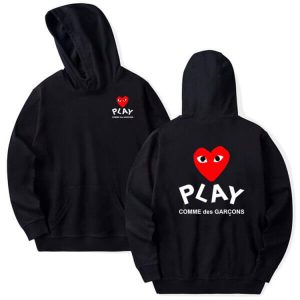In the world of high fashion, where trends often dictate aesthetic boundaries and wearable norms, Comme des Garçons has long stood as an unapologetic outlier. Established by Japanese designer Rei Kawakubo in 1969, the brand has never merely created clothing. Instead, it has challenged Comme Des Garcons conventions, defied expectations, and redefined what fashion can be. With designs that blur the line between art and fashion, Comme des Garçons has carved out a distinct space where garments are not just worn—they are experienced.
A Revolutionary Beginning
When Rei Kawakubo brought Comme des Garçons to Paris in the early 1980s, her work shocked the fashion establishment. Black, distressed fabrics, asymmetrical silhouettes, and deconstructionist techniques were in stark contrast to the glamorous, polished aesthetic that dominated the runways. Critics were initially confounded. Her debut was described by some as “Hiroshima chic,” reflecting how disruptive and radical her vision appeared to Western audiences.
But Kawakubo was not simply rebelling for the sake of rebellion. Her designs spoke to a deeper, more philosophical exploration of identity, beauty, and the human form. Her approach was intellectual and rooted in the avant-garde, aligning more closely with conceptual art than traditional fashion. It was the beginning of a legacy that would forever alter the boundaries between clothing and artistic expression.
Fashion as Sculptural Form
One of the defining characteristics of Comme des Garçons is its embrace of sculptural design. Kawakubo’s garments often defy conventional notions of how clothing should fit or function. Her 1997 collection “Body Meets Dress, Dress Meets Body,” colloquially known as the “lumps and bumps” collection, featured padded, bulbous shapes sewn into the fabric. The pieces distorted the human figure in ways that questioned societal standards of attractiveness and forced viewers to reconsider what beauty could mean.
Rather than following the contours of the body, Comme des Garçons designs often create entirely new shapes. These architectural garments serve as moving installations, emphasizing abstraction over utility. Much like a piece of modern sculpture, each creation invites interpretation. The human body becomes a canvas, and the clothing becomes an expressionist medium, forming a visual dialogue between wearer and viewer.
Breaking the Rules to Redefine Beauty
Central to Kawakubo’s philosophy is a deliberate rejection of traditional beauty. She has frequently stated that she creates “beautiful things that aren’t,” illustrating her belief that beauty is subjective and that fashion can—and should—challenge cultural norms. Whether it’s through asymmetry, unconventional fabric combinations, or garments that conceal rather than reveal, Comme des Garçons pushes viewers to expand their understanding of aesthetics.
This conceptual stance places Kawakubo in the realm of artists who question the status quo. Her designs can provoke discomfort, admiration, confusion, or awe—all emotions commonly associated with powerful art. She doesn’t just design clothes; she stages confrontations between form and function, past and future, masculinity and femininity. In doing so, she disrupts the passive consumption of fashion and asks the audience to think critically.
Runway as Performance Art
Comme des Garçons’ runway shows are themselves exercises in artful provocation. Each show is meticulously curated not only in clothing design but also in music, lighting, and choreography. The models often walk in solemn silence or with a purposeful intensity, underscoring the theatrical quality of the presentation. These are not mere displays of seasonal trends; they are performance pieces that communicate complex ideas about society, politics, and emotion.
In many ways, Kawakubo treats the runway as a gallery. Each collection has a narrative arc, a conceptual backbone that gives meaning to the visual spectacle. Whether exploring themes of loss, identity, rebirth, or resistance, the shows function as immersive experiences that linger long after the garments leave the stage. The atmosphere created at a Comme des Garçons show is one of introspection and intellectual engagement—a hallmark of fine art.
Collaboration and Cross-Disciplinary Influence
Comme des Garçons has also become a hub for cross-disciplinary innovation, collaborating with artists, architects, and designers across various fields. From the iconic Dover Street Market retail concept to partnerships with brands like Supreme and Nike, the label seamlessly merges high art sensibilities with street-level accessibility.
Kawakubo’s collaboration with performance artists and visual creatives reflects her commitment to breaking down the silos between fashion and other art forms. She’s curated exhibitions, designed museum installations, and even launched her own publishing house. These ventures reinforce the idea that Comme des Garçons is not just a fashion brand—it is a cultural force that operates at the intersection of creativity and commerce.
Comme des Garçons in Museums and Academia
The brand’s influence extends well beyond the runway and retail. Comme des Garçons has been the subject of numerous museum retrospectives, including the landmark 2017 exhibition at The Metropolitan Museum of Art’s Costume Institute titled “Rei Kawakubo/Comme des Garçons: Art of the In-Between.” This was only the second time the Met dedicated a solo exhibition to a living designer, following Yves Saint Laurent.
The exhibition underscored how deeply Kawakubo’s work resonates within art history, theory, and criticism. Her creations were displayed as standalone sculptures, devoid of mannequins in some cases, underscoring their conceptual weight. Academics continue to explore her contributions in disciplines ranging from feminist theory to architecture, further cementing her place as a visionary who transcends fashion’s commercial boundaries.
Enduring Legacy and Future Influence
Rei Kawakubo’s influence can be felt in the works of countless contemporary designers, from Rick Owens to Iris van Herpen. Her fearlessness has inspired a new generation of creatives to approach fashion as a space for intellectual exploration and emotional expression. But even as trends come and go, Comme des Garçons remains a singular voice—forever questioning, evolving, and redefining.
The brand’s refusal to be pigeonholed ensures its Comme Des Garcons Hoodie relevance in a world where authenticity and innovation are increasingly valued. In many ways, Kawakubo’s work is a mirror, reflecting society’s contradictions and complexities back at us. Her garments ask questions rather than provide answers, and in doing so, they invite us to consider the profound role that clothing plays in shaping identity and cultural discourse.
Conclusion: A Vision Beyond Fabric
Comme des Garçons is not just about what we wear—it’s about how we see ourselves and the world. By blurring the lines between art and fashion, Rei Kawakubo has elevated the runway into a space of intellectual inquiry and emotional depth. Her work continues to challenge the fashion industry’s preconceptions and offers a powerful reminder that true innovation comes not from following rules but from breaking them.
In a culture that often prioritizes surface over substance, Comme des Garçons stands as a testament to the enduring power of radical creativity. Kawakubo’s legacy is not just a collection of garments; it is a living, breathing philosophy that reshapes how we define beauty, purpose, and the possibilities of design.



